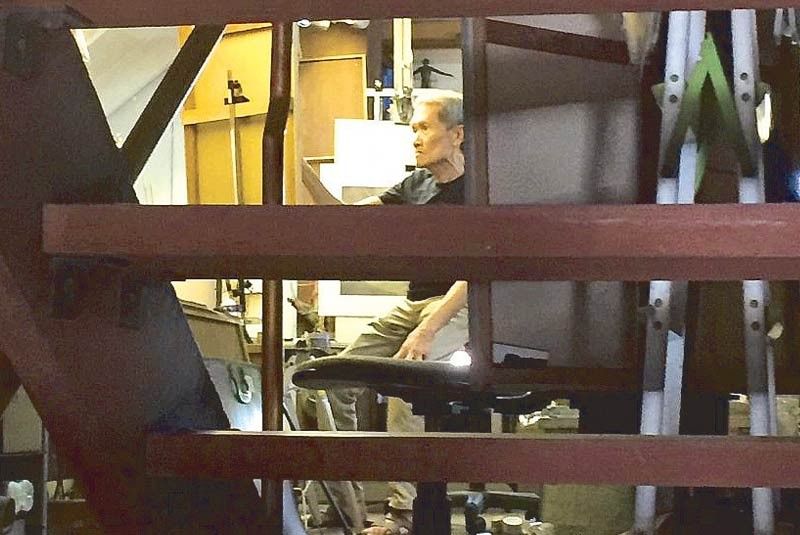Agustin Goy’s house of idyll in these mad, contemporary times

Agustin Goy — artist, architect, and one of the most self-effacing men you’ll ever meet — welcomes us to his home and says, “Tuloy kayo dito sa bahay ng kalapati.”
It’s quite surreal (a concept that does not rear its head inside Goy’s paintings of animals at rest, graceful ballerinas, and idyllic Filipino life rendered in a masterful classical-realist style) to go from the carmageddon of Commonwealth Avenue and right into a Q.C. village and Goy’s house deliberately made to look pastoral and comfortingly provincial. For a moment there, you’d think you installed yourself somewhere in the late ‘50s or early ‘60s in Binangonan or Antipolo where the master, Vicente Manansala, is mentoring the young Agustin Goy, their hands transmuting the hills and valleys right in front of them, with an eyeful of skies, while the future — gray and foreboding — hasn’t been penciled in yet.
“I finished building this house in 1980,” Goy, now in his early 80s, says. “I wanted to make it as simple as possible. Builders these days spend so much on outside decoration that doesn’t have any function at all.”
The way the man explains it is simple: since the lot that Goy bought was small, he stuck to a square, and created levels instead.
“I played with levels — all six of them,” he says pointing out the stacked platforms that make up his home, including an attic, basement and a well-lit studio where most of the painterly magic happens. “I’ve expanded vertically.”
When the house was built, hardly any other houses were around, thus Agustin’s studio had a picturesque view of Marikina and Montalban. Imagine that fabled Filipino sunlight, which mesmerized Fernando Amorsolo, streaming into the canvas. And at night glowed the secret messages of stars.
Going up each level of Goy’s house is like a mini trip in itself. A vintage bike is ensconced in the entranceway, while a stained glass door brings in color; a glass rack of vintage toy cars provides a bit of unbalance to a corner of folk statues and shells lining up a window; the house is well lit by sunlight and antique lanterns; the framed graphic art and illustrations of Goy’s daughter, Abi, communicate frolicsome charm and youthfulness, while the suite of paintings by Manansala, Ang Kiukok, H.R. Ocampo, Cesar Legaspi, and Agustin himself imparts experience and enlightenment.
“I always tell Abi, ‘You must make excellence a habit.’”
Agustin grew up in Binondo, Manila. His parents, who ran a shirt factory supplying uniforms to Manila Hotel and such, persuaded him to take up architecture instead of fine arts. In one of the rendering classes, Goy met Manansala who became his lifelong mentor. They even became neighbors at one point in San Francisco del Monte.
Goy says that when he went to Manansala’s house, the master showed him the studio with a view of the river and Meycauayan across it. “It was like an Amorsolo painting! Mang Enteng (Manansala) would catch shrimp in the morning and have grilled shrimp for breakfast.”
Goy helped Manansala with his commissioned murals, scaling up the master’s studies, and taking on the task of putting “mantsa” (underpainting). On Sundays, the two would go up to Antipolo or Binangonan, with the young artist driving the elder one’s Volkswagen Buggy. They hiked up the mountains and sketched the beauty that they saw.
Those plein air trips and art talks with Manansala are a lifetime ago.
Agustin shows us a newspaper clipping of Mang Enteng beside a young Goy and his works in watercolor. His first one-man show opened at Hidalgo Gallery in 1972. What lies ahead was still sketchy at best.
The old master has departed long ago, and Goy has a show titled “Sixty Years of Art” on view until March 19 at the National Museum. And he doesn’t want to call it a “retrospective.”
“What I want is to simply feature the three things that every artist has to be capable of doing: still life, landscape and figures. For me, they show a progression in terms of movement and level of difficulty in execution.” The exhibit features 62 paintings from 1976 to 2016 personally selected by the artist.
“Each of my paintings has a story,” Goy explains. “For example, this one (showing a painting of a horse-drawn carriage in one of his catalogues). Doon sa amin noon sa Talayan, tuwing Sunday ay may karera ng tiburin. ‘Yan ‘yung sports car noong araw. They were decorated like jeepneys. Pasikatan! I wanted to immortalize that; capture that memory.”
He has also done portraits of his wife Angelina, daughters Anna Marie and Abi, Don Jaime Zobel de Ayala and his son Fernando, as well as Emilio Aguilar Cruz (popularly known as Abé) who was a writer, painter and cultural impresario.
Agustin hardly donned his architect’s hat, but he undertook a number of projects for Abé’s son and Goy’s friend, the restaurateur Larry J. Cruz (LJC), designing Café Adriatico, Bistro Remedio and Abé’s Farm in Magalang, Pampanga, among others, highlighting Filipino antiques and design aesthetics.
Larry J. Cruz and Goy even found an old 1930s house in the town of Magalang, tore it down, and faithfully reconstructed it part by part inside Abé’s Farm — an out-of-time structure amid the restaurant and spa in the compound.
This was also a lifetime ago with its cavalcade of departed mentor (Manansala in 1981), friend (Larry J. Cruz in 2008) as well as a satellite of colleagues. But life and art do go on.
Goy’s wife tells us that her husband still paints every day from 1 to 4 a.m. because the sound of passing tricycles throughout the day disturbs him. Imagine that. As this contemporary, culturally bankrupt world goes go sleep, Agustin Goy is wide-awake, drinking his preferred tea, and busily painting ballet dancers, beasts of burden and sunlight-dappled ricefields in his studio.
The rustic never sleeps.
Photos by WALTER BOLLOZOS



















